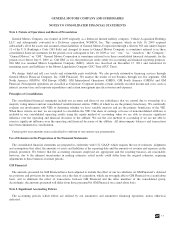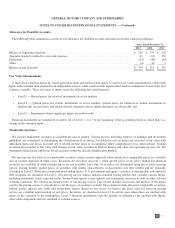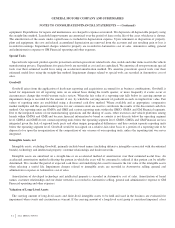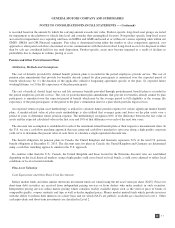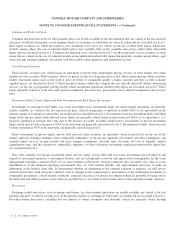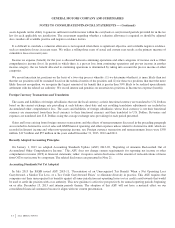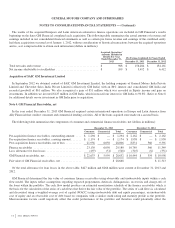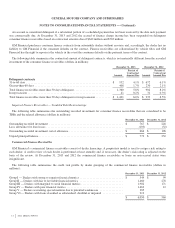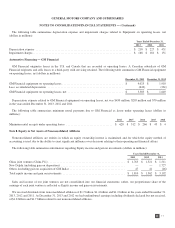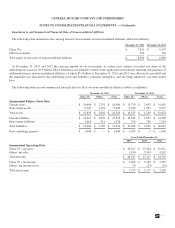General Motors 2013 Annual Report Download - page 70
Download and view the complete annual report
Please find page 70 of the 2013 General Motors annual report below. You can navigate through the pages in the report by either clicking on the pages listed below, or by using the keyword search tool below to find specific information within the annual report.
GENERAL MOTORS COMPANY AND SUBSIDIARIES
NOTES TO CONSOLIDATED FINANCIAL STATEMENTS — (Continued)
assets depends on the ability to generate sufficient taxable income within the carryback or carryforward periods provided for in the tax
law for each applicable tax jurisdiction. The assessment regarding whether a valuation allowance is required or should be adjusted
also considers all available positive and negative evidence factors.
It is difficult to conclude a valuation allowance is not required when there is significant objective and verifiable negative evidence,
such as cumulative losses in recent years. We utilize a rolling three years of actual and current year results as the primary measure of
cumulative losses in recent years.
Income tax expense (benefit) for the year is allocated between continuing operations and other categories of income such as Other
comprehensive income (loss). In periods in which there is a pre-tax loss from continuing operations and pre-tax income in another
income category, the tax benefit allocated to continuing operations is determined by taking into account the pre-tax income of other
categories.
We record uncertain tax positions on the basis of a two-step process whereby: (1) we determine whether it is more likely than not
that the tax positions will be sustained based on the technical merits of the position; and (2) for those tax positions that meet the more
likely than not recognition, we recognize the largest amount of tax benefit that is greater than 50% likely to be realized upon ultimate
settlement with the related tax authority. We record interest and penalties on uncertain tax positions in Income tax expense (benefit).
Foreign Currency Transactions and Translation
The assets and liabilities of foreign subsidiaries that use the local currency as their functional currency are translated to U.S. Dollars
based on the current exchange rate prevailing at each balance sheet date and any resulting translation adjustments are included in
Accumulated other comprehensive loss. The assets and liabilities of foreign subsidiaries whose local currency is not their functional
currency are remeasured from their local currency to their functional currency and then translated to U.S. Dollars. Revenues and
expenses are translated into U.S. Dollars using the average exchange rates prevailing for each period presented.
Gains and losses arising from foreign currency transactions and the effects of remeasurements discussed in the preceding paragraph
are recorded in Automotive cost of sales and GM Financial operating and other expenses unless related to Automotive debt, which are
recorded in Interest income and other non-operating income, net. Foreign currency transaction and remeasurement losses were $350
million, $117 million and $55 million in the years ended December 31, 2013, 2012 and 2011.
Recently Adopted Accounting Principles
On January 1, 2013 we adopted Accounting Standards Update (ASU) 2013-02, “Reporting of Amounts Reclassified Out of
Accumulated Other Comprehensive Income.” This ASU does not change current requirements for reporting net income or other
comprehensive income (OCI) in financial statements; rather, it requires certain disclosures of the amount of reclassifications of items
from OCI to net income by component. The related disclosures are presented in Note 21.
Accounting Standards Not Yet Adopted
In July 2013 the FASB issued ASU 2013-11, “Presentation of an Unrecognized Tax Benefit When a Net Operating Loss
Carryforward, a Similar Tax Loss, or a Tax Credit Carryforward Exists” to eliminate diversity in practice. This ASU requires that
companies net their unrecognized tax benefits against all same-jurisdiction net operating losses or tax credit carryforwards that would
be used to settle the position with a tax authority. This new guidance is effective prospectively for annual reporting periods beginning
on or after December 15, 2013 and interim periods therein. The adoption of this ASU will not have a material effect on our
consolidated financial statements because it aligns with our current presentation.
68
2013 ANNUAL REPORT



